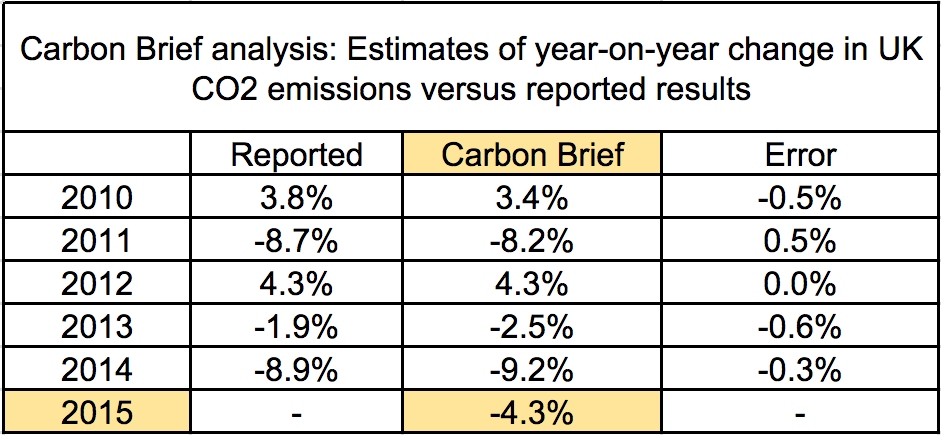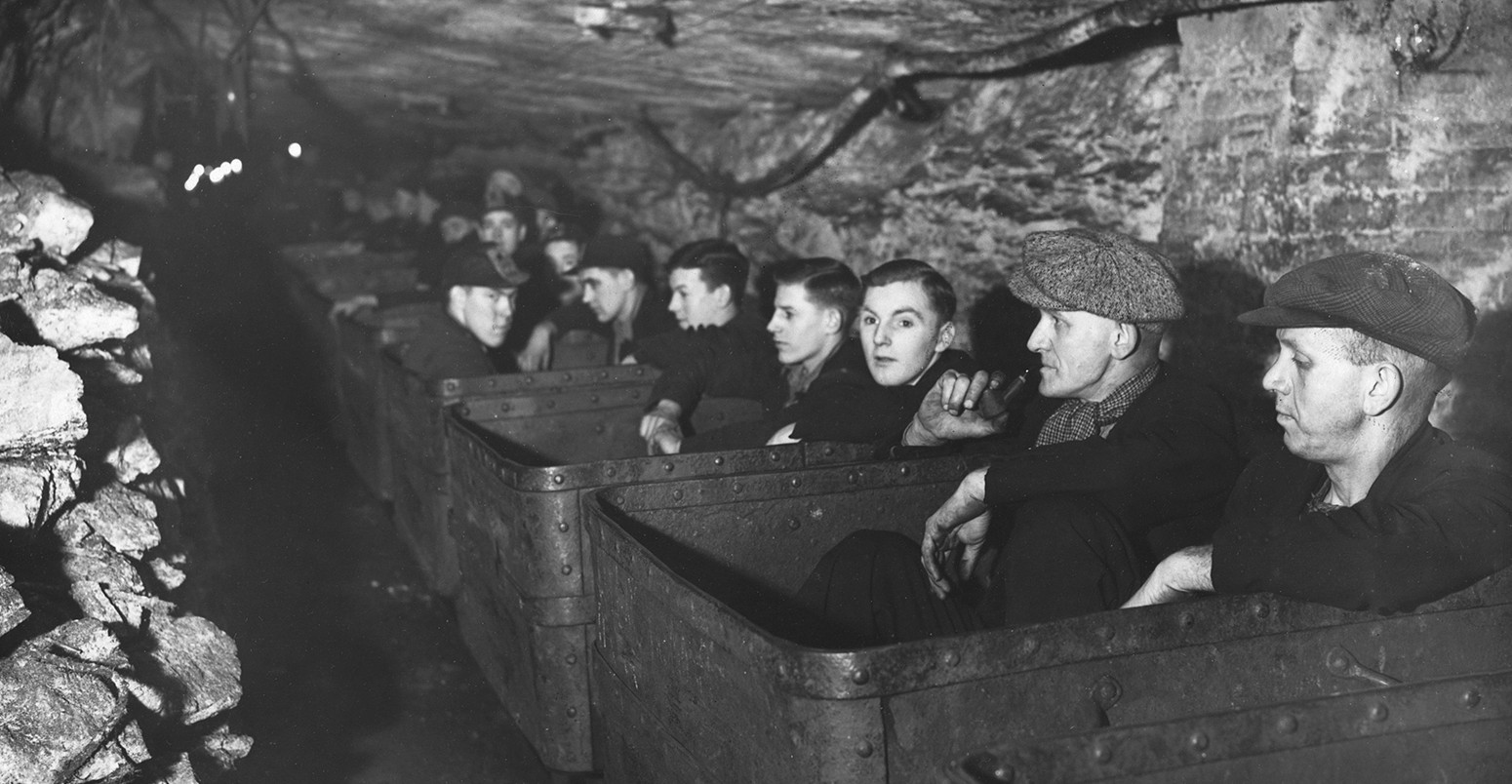
Analysis: UK emissions fall again after record drop in coal use in 2015
Simon Evans
02.25.16Simon Evans
25.02.2016 | 4:15pmThe UK’s CO2 emissions fell by 4.3% in 2015 on the back of the largest recorded annual drop in coal use, outside of a miners’ strike, Carbon Brief analysis shows.
The reduction would leave UK CO2 emissions 31.5% below 1990 levels. The fall in coal use also takes UK consumption to its lowest level in records stretching back to the start of the industrial revolution.
The findings are based on Carbon Brief analysis of official government energy use figures released today. The Department of Energy and Climate Change (DECC) will publish its own provisional estimates on 31 March.
Coal crash
Coal consumption in 2015 was 22% lower than in 2014, falling to 38m tonnes (grey area, chart below). This was the largest-ever reduction, apart from those seen during miners’ strikes in 1921, 1926 and 1984 (red bars, below).
Each strike was followed by a large rebound in coal use, whereas consumption is expected to continue falling through 2016. Last year’s record fall also comes after an 18% reduction between 2013 and 2014, which is now the second largest reduction outside of strike years.
UK coal use is now down 41% in three years. When UK coal use peaked in 1956, the country was burning six times as much of the black stuff.
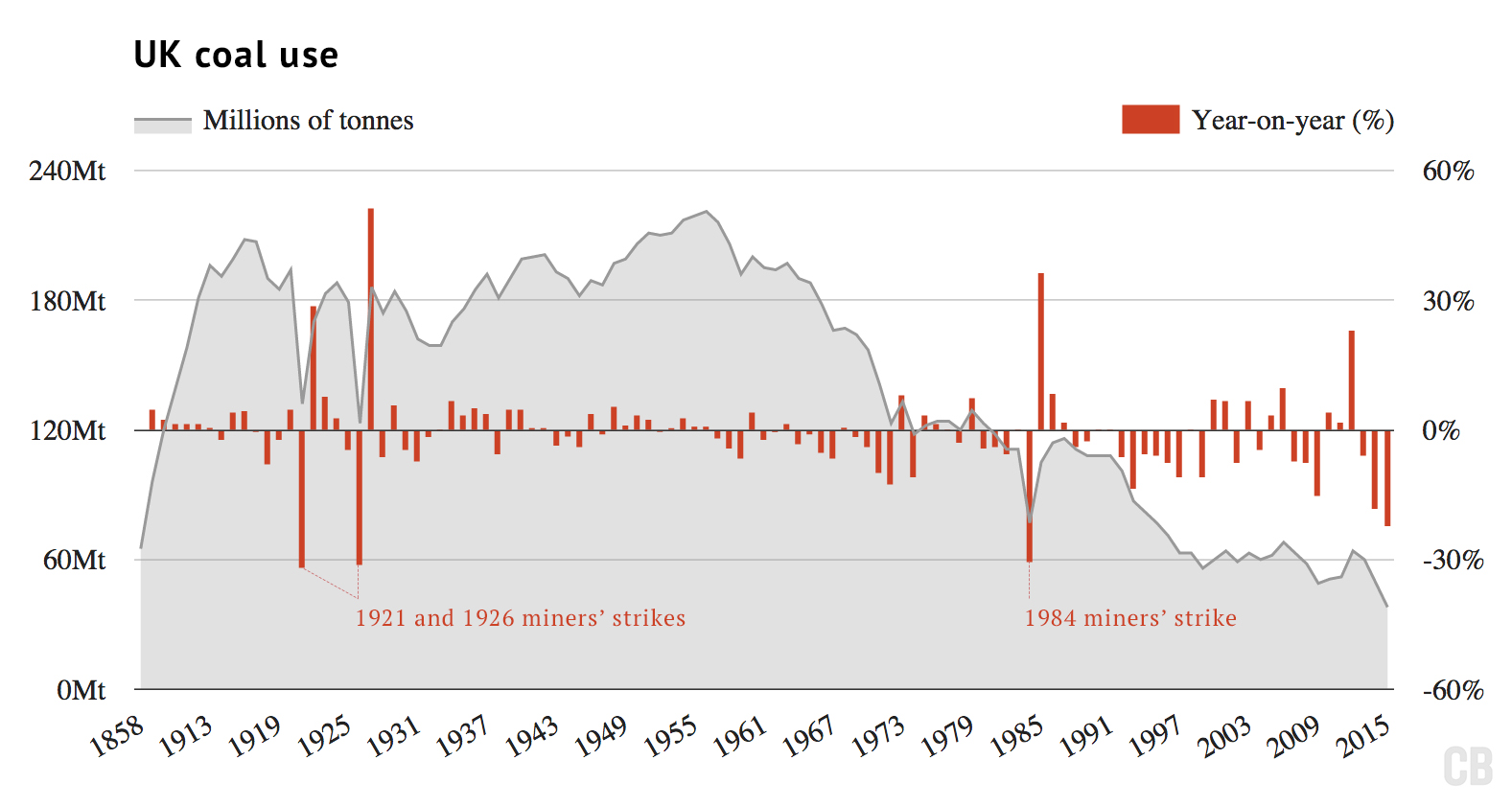
Left axis and grey area: UK coal use since the industrial revolution, millions of tonnes. Right axis and red bars: year-on-year change in coal use, %. Sources: DECC Energy Trends table 2.6, historical data and Carbon Brief analysis. Chart by Carbon Brief.
The fall in coal consumption since 2012 is a result of several factors. First, a number of ageing coal-fired power stations have closed. This trend is set to continue, with another 8 gigawatts of coal capacity planning to close in 2016 — nearly half the remaining total.
The coal plants closing this year were responsible for 6% of total UK CO2 emissions in 2014. Amber Rudd, energy and climate change secretary has pledged to phase out unabated coal by 2025. A consultation on the details is due this spring.
The second factor weighing on coal use is that Drax, the UK’s largest coal-fired power station, has been progressively converted to burn wood pellets instead of coal. Three of its six units now run exclusively or predominantly on biomass, with the third unit switching to 85% biomass during 2015.
Third, coal plants’ profitability has plummeted as a result of falling wholesale electricity prices and the rising carbon floor price, the UK’s top-up carbon tax. Wholesale prices are falling as a result of cheaper gas and the rise of renewables, which generate power at near-zero cost once built.
Finally, coal use at steelworks also fell in 2015. The sector is in crisis, largely because of cheap Chinese exports flooding the market.
Emissions down
UK CO2 emissions from burning coal fell by 22% to around 75m tonnes in 2015, Carbon Brief analysis suggests. This is also a record low.
In total, UK CO2 emissions in 2015 were an estimated 4.3% lower than a year earlier, and 31.5% below 1990 levels. The reduction came even as the economy grew by 2.2%.
It also follows a record 9% reduction in UK CO2 emissions in 2014. Emissions in 2015 were nearly a fifth lower than in 2010, the year prime minister David Cameron took office.
While CO2 emissions from coal use fell last year, those from burning oil and gas increased slightly. Carbon Brief estimates oil-related CO2 emissions increased by 1.4% in 2015 while CO2 from gas was up by 3.0%.
Oil use increased on falling crude prices. Gas use was up because 2015 was cooler than 2014, the UK’s hottest year on record. Wholesale gas prices were also down slightly compared to 2014.
Energy and electricity
Total UK primary energy use continued its long decline, reaching the lowest level in a generation (chart, below). This reflects energy efficiency improvements and the rise of renewables.
Final electricity output from wind and solar is assumed to be equal to the primary energy input. In contrast, most of the primary energy content of fossil fuels, such as coal, is wasted as heat dispersed in cooling towers. Only a minority of this primary energy is converted to electricity.
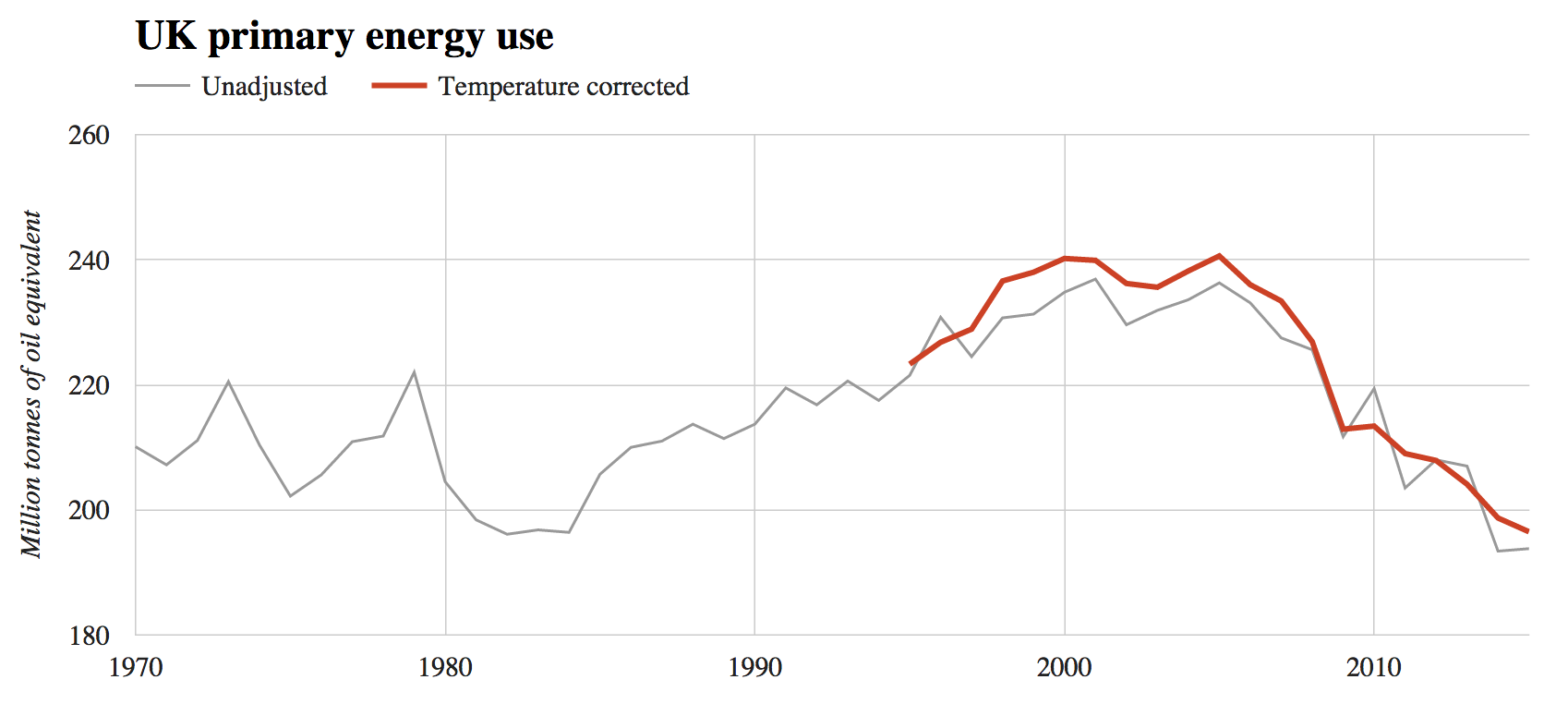
UK primary energy use since 1970. Grey line: unadjusted raw energy use data. Red line: energy use adjusted for temperatures. This smooths out the impact of warmer or cooler years on heating demand. Source: DECC. Chart by Carbon Brief.
The fall in coal-fired electricity generation (blue line, below) was offset by increases in nuclear and renewable output (green, orange and purple lines).
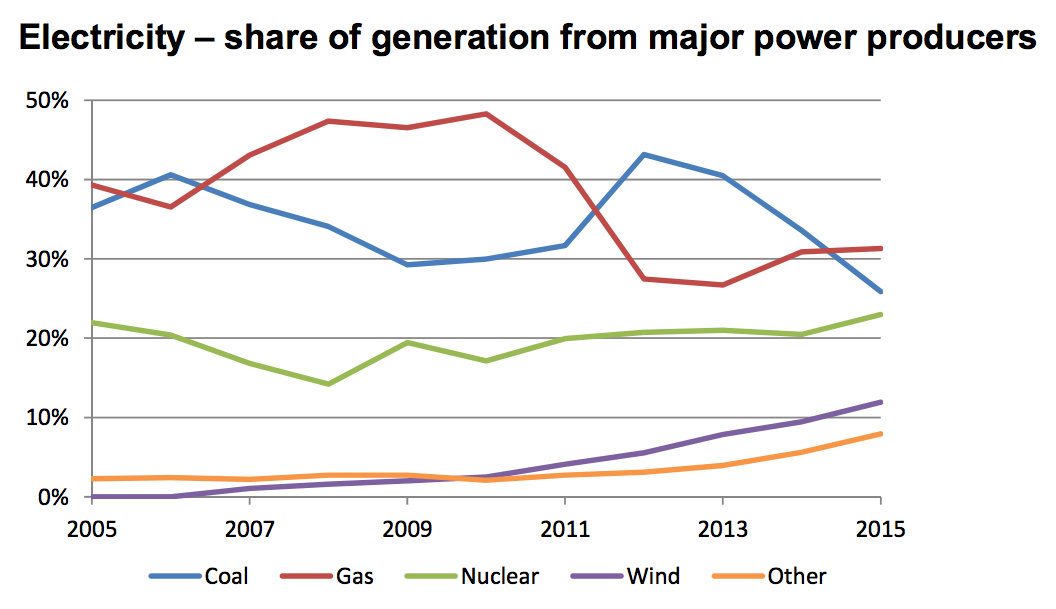
Share of electricity generation by source. Other (orange line) includes biomass and hydro. Note that the chart only shows major power producers’ generation, which account for around 85% of total generation. It does not include small-scale renewables, such as solar, which topped 10 gigawatts capacity last year. Source: DECC.
For nuclear, the increase in 2015 reflects an improvement over 2014, when several reactors were affected by unexpected outages because of cracks found in their boilers.
For renewables, the increase in 2015 reflects additional generation capacity as Drax continued its biomass conversion and more windfarms were added.
Carbon Brief calculations
Carbon Brief’s estimates of UK CO2 emissions in 2015 are based on analysis of provisional UK energy use data published by DECC. The same approach has accurately estimated year-to-year changes in emissions over the past five years (see table).
For instance, Carbon Brief estimated a 9.2% fall in UK CO2 emissions between 2013 and 2014. DECC then provisionally reported a 9.7% reduction.
It’s worth noting that both the energy use and CO2 emissions data are subject to revision. While DECC provisionally reported a 9.7% CO2 cut last year, its final data showed an 8.9% reduction.
UK greenhouse gas emissions will have fallen around 4.5% in 2015 to 491m tonnes of CO2 equivalent, Carbon Brief analysis suggests, assuming the ratio between CO2 and other greenhouse gas emissions is similar to previous years.
This would be the first time UK greenhouse gas emissions have fallen below half a billion tonnes since the 1940s, and possibly even earlier.
The reduction would place UK greenhouse gas emissions an estimated 38% below 1990 levels. The third carbon budget for 2018-2022 calls for a 35% reduction, though this comparison should be treated with caution since the budget is measured against a different total.
The UK’s estimated 491MtCO2e greenhouse gas emissions total in 2015 would have placed the UK outside the global top-20 emitters in 2012, below the likes of Iran, Saudi Arabia and Myanmar. Data on these countries’ emissions in 2015 is not available.
Main image: British coal miners wait in ore cars for their shift to begin, 1939, UK.
-
Analysis: UK emissions fall again after record drop in coal use in 2015
-
The UK's #emissions fell by 4.3% in 2015 after largest recorded annual drop in #coal use


